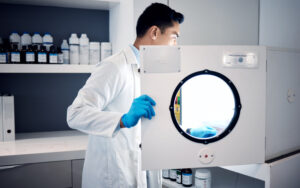As an experienced UK veterinarian, you understand the crucial role autoclaves play in protecting animal patients. Used for sterilising surgical tools and other equipment, regular maintenance of these machines is necessary if they’re to operate optimally. In this guide, we will walk through each step necessary to extend autoclave machines’ lifespan while keeping them performing at their best for continued veterinary excellence.
Daily Cleaning and Inspection
A clean autoclave is key for effective sterilisation processes. Therefore, at the end of every day, it’s important to clean its exterior surfaces using mild disinfectants. Also, inspect its door gasket for signs of wear or damage and clean it using a damp cloth before draining any remaining water from its reservoir to prevent bacterial growth. Make sure to check its tray racks chamber for debris or residue that might impede this process.
Water Quality
Water quality is of critical importance in maintaining the operation of autoclaves. For optimal performance, use only distilled or deionised water to avoid mineral build-up in its reservoir and chamber. Check the water level and add or top off as necessary and replace regularly according to the manufacturer’s recommendations.
Regular Maintenance Checks
It is critical to schedule regular maintenance checks with a trained technician in order to keep your autoclave machine operating smoothly, such as inspecting and calibrating pressure gauges, safety valves, and temperature controls. As soon as any problems arise it’s best to address them swiftly to avoid costly downtime and equipment failure.
Test Runs and Validation
To ensure optimal autoclave sterilisation parameters, conduct regular test runs and validation procedures. This can be done using biological or chemical indicators recommended by your autoclave manufacturer to assess its sterilisation process’s efficiency.
The Best Autoclave Machine Tests to Run
The Bowie-Dick Test
The Bowie-Dick test cycle is a daily procedure used to evaluate autoclaves’ performance in removing air and allowing proper steam penetration. It involves placing a test pack inside the autoclave and running a sterilisation cycle. The results are determined by observing any colour changes on the test sheet.
The Vacuum Leak Test
The Vacuum Leak Test checks for leaks in the autoclave chamber or sealing gasket. The process involves starting a sterilisation cycle, during which the autoclave creates a vacuum. If the pressure remains stable, it indicates no leaks. However, a rapid increase suggests a pressure leak that needs to be repaired.
The Helix Test
The Helix Test measures the strength of steam penetration into the autoclave chamber, crucial for sterilising hollow instruments. This test uses a long tube with a chemical indicator strip that changes colour if sterilisation conditions are met. Regular performance of the Helix Test ensures all instruments are properly sterilised, preventing potential bacterial or viral spread.
Door Seal Maintenance
A properly functioning autoclave door seal is integral to its effectiveness. Be sure to regularly inspect the seal for signs of wear or damage and replace it if necessary. A properly working seal ensures pressure and temperature stability during sterilisation cycles, keeping them at just the right levels for efficient performance.
Comply With Autoclaves Manufacturer Guidelines
Always referring to the operation and maintenance manual is key when maintaining an autoclave machine as these include tips and guidelines from its manufacturer for optimal performance and troubleshooting common issues.
Dentalex Medical veterinary autoclaves are designed with the user in mind and come with comprehensive manufacturer guides that detail best practices for maintenance and cleaning. These guides provide invaluable information, from routine daily cleaning to more in-depth monthly maintenance tasks. They cover everything from the correct use of autoclave cleaners to the importance of using distilled water only.
Training and Staff Education
Provide your veterinary staff with adequate instruction on the operation and maintenance of their autoclave. Emphasising its use according to prescribed procedures, such as correctly loading instruments into it for sterilisation cycles and using them correctly. Educate them as to the importance of following all required steps, such as following prescribed loading procedures correctly before sterilisation cycles begin.
Monitor Autoclaves Usage and Performance
Keep a record of when and how frequently your autoclave is being used and periodically assess its performance to help identify patterns or anomalies that could indicate it needs maintenance or repairs. This data could reveal patterns or anomalies which might indicate when maintenance or repairs may be required.
Plan for Downtime
Even with regular maintenance, autoclaves may occasionally need servicing or repairs. To minimise disruption to your practice’s workflow during this period of downtime, establish a plan in advance that covers this scenario.
Conclusion
By following these maintenance guidelines, you can ensure your autoclave remains reliable and consistently sterilises equipment to the highest UK standards in your veterinary practice. Remember that having a properly functioning autoclave is critical not only to ensure the well-being of your furry patients but also the longevity of your practice as a whole.
